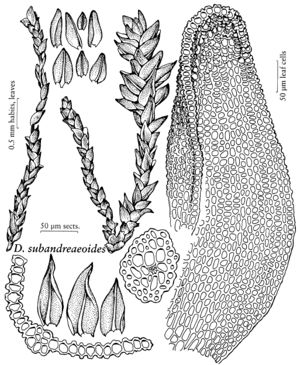Didymodon subandreaeoides
Phytologia 41: 23. 1978,.
Plants red- or black-brown. Stems to 1 cm, central strand present or rarely absent. Leaves dimorphic: leaves on main stems leaves appressed when dry, weakly spreading and not keeled when moist, ovate-triangular or ovate-lanceolate to lanceolate, broadly concave adaxially across leaf, usually (0.3–)0.5–0.6(–0.8) mm, base scarcely differentiated in shape, margins plane to weakly recurved at mid leaf, minutely crenulate, apex rounded-obtuse to obtusely acute, seldom narrowly acute; costa ending 3–6 cells below the apex, not strongly spurred, not much widened or tapering, without an adaxial pad of cells, adaxial costal cells quadrate, 2 cells wide at mid leaf, guide cells in 1 layer; basal laminal cells weakly differentiated medially, walls thickened, short-rectangular, not perforated; distal laminal cells 9–12 wide, 1:1, papillae low, simple or scablike, 1 over each lumen, rarely absent, lumens angular to ovate, walls evenly thickened, weakly convex on both sides of lamina, 1-stratose; leaves of branchlets oval to orbicular, strongly concave, cochleariform, about 0.2 mm, julaceous, distal laminal cells short-rectangular, 7–11 µm wide, 1–2:1. Specialized asexual reproduction specialized structures absent. Sexual condition only perichaetial plants seen. Sporophytes unknown. Distal laminal KOH reaction red.
Habitat: Limestone outcrops, cliffs, bluffs, soil pockets in granite, tundra, along streams or associated with waterfalls
Elevation: moderate to high elevations (600-3500 m)
Distribution

Alta., B.C., N.W.T., Yukon, Alaska, Colo., Europe.
Discussion
Recently, J. Kucera and H. Köckinger (2000) demonstrated that the widely distributed (Austria, France, Germany, Romania, Slovakia, Switzerland) Old World species Grimmia andreaeoides Limpricht is a synonym of Didymodon subandreaeoides, which is distributed along inland mountain ranges from the North Slope of Alaska south along the Cordillera into Colorado. It is commonly associated with Molendoa sendtneriana, with which it is often mixed in collections and which apparently has a similar distribution in northwestern North America. The fragile, cochleariform-leaved branchlets may possibly figure in asexual reproduction. Andreaea rothii when without sporophytes may be confused with D. subandreaeoides, but may be distinguished by the former’s autoicous inflorescence, the ecostate, oblong perichaetial leaves, leaves monomorphic, cauline leaves plane, cells with bulging but epapillose bright orange walls, 2-stratose along the distal margins, middle lamellae often evident between proximal cells, and costa not sharply distinguished from lamina beyond mid leaf.
Selected References
None.
